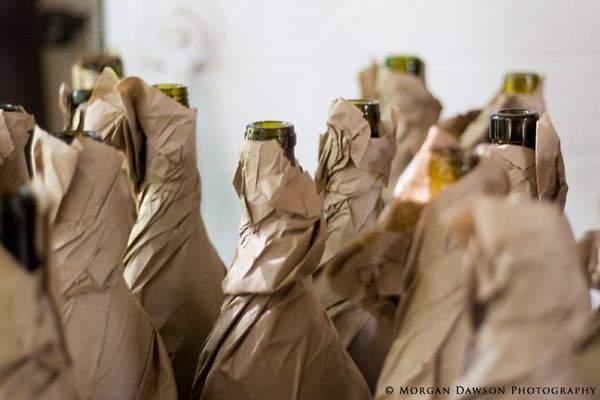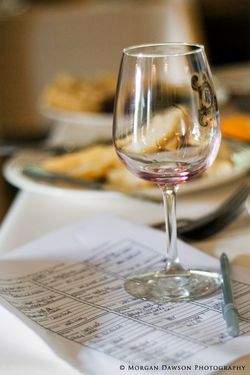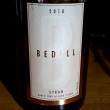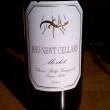Blind Tasting of Finger Lakes Pinot Noir Reveals Progress, Challenges
Posted
July 2, 2009 by Evan Dawson in
News & Events

By Evan Dawson, Finger Lakes Editor
Photos by Morgan Dawson Photography
On Wednesday night, on a rain-soaked evening on the southeast side of Seneca Lake, a group of grape growers and winemakers met to taste through a line of 2007 pinot noirs. Many of the wines were made in the Finger Lakes; a few came from the American West Coast, and some from Burgundy.
Tom Higgins, winemaker and owner of Heart & Hands Wine Company, organized the event because he wanted to know: Where does pinot noir stand in the Finger Lakes? Is it truly a recalcitrant mystery, yielding near-constant mediocrity at best? Or is there evidence that the great grape of Burgundy can produce some stunning wines here?
"I think by the end of this tasting we'll have a much better idea of what's going on with pinot in the Finger Lakes," Tom said as the group took shape inside the Stonecat Cafe.
Higgins set out the brown-bagged bottles, numbered 1 through 19, on several long tables. Finger Lakes pinots included those from Heart & Hands, Sheldrake Point Vineyard, Wagner Vineyards, Atwater Estate Vineyards, Dr. Konstantin Frank Vinifera Wine Cellars, Billsboro Winery, Ravines Wine Cellars, Fox Run Vineyards, Damiani Wine Cellars, and Hosmer Vineyard. French wines included two lower-level Burgundies. From the West Coast, one bottle came from the Oregonian producer WillaKenzie and another from Carneros.
For nearly an hour the group tasted and scribbled notes. Some discussed the aromatics and flavors during the tasting; others, including Ravines' winemaker Morten Hallgren, preferred to taste in solace — perhaps to avoid confirmation bias that arises during tasting discussions. Higgins did not ask the group to score the wines.
 When the food arrived, Higgins began to reveal the wines one by one, asking the group first for their impressions. The French wines were duds, sadly; I'd have preferred to shell out a bit more to see how a more pricey Burgundy would have faired. From the West Coast, the Carneros performed surprisingly nicely, due largely to its subtle style that avoided the syrupy extract bombs that so often color the West Coast pinot scene these days.
When the food arrived, Higgins began to reveal the wines one by one, asking the group first for their impressions. The French wines were duds, sadly; I'd have preferred to shell out a bit more to see how a more pricey Burgundy would have faired. From the West Coast, the Carneros performed surprisingly nicely, due largely to its subtle style that avoided the syrupy extract bombs that so often color the West Coast pinot scene these days.
From the Finger Lakes, pinot noir proved to be a mixed — but undeniably intriguing — bag.
The local producer that won the most kudos was Damiani, and grower Phil Davis explained that one of the wines (he brought both the 2007 and the 2007 Reserve) was unfiltered and unfined. In fact, the 2007 Damiani Pinot Noir was the cloudiest red wine I had ever seen in a glass, and yet it was seductive and complex. That's no surprise, as Davis keeps yields painstakingly low and brings a passion for pinot that has shown up on other visits to the winery.
The 2007 Ravines Pinot Noir came off as tight as a drum to me, which again was no surprise. I recently drank a bottle of the Ravines 2005 Pinot Noir and it was positively glowing, evolving aromatically over the course of several hours and offering gorgeous length. Winemaker Morten Hallgren called his 2007 "an infant," and I wondered if the table had just committed infanticide.
In fact, as a group I found the 2007 Finger Lakes Pinot Noirs to need more time to properly consider. Most of the industry professionals agreed, and they resolved to try the same flight of 2007 wines again in a year's time. That, I am sure, will be much more instructive. Wagner's Ann Raffetto disagreed, saying that Finger Lakes Pinots need to be drunk young, but she was alone with that opinion.
Other wines of note included the Heart & Hands 2007 Barrel Reserve Pinot Noir, which my wife was able to pick out of the lineup of 19 wines — an impressive feat, and a sign that Higgins is already crafting memorable wines! Fox Run's 2007 Reserve was showing very nicely — I thought it might have been the inspiration for John Mellencamp's song "Cherry Bomb" — but the Fox Run 2007 regular release was disjointed and awkward. "We've experienced some variation," assistant winemaker Tricia Renshaw explained. "There are times we taste the wine and want to get rid of the entire barrel, and at other times it moves in the direction we want to see it go. But certainly it's still a bit young to know for sure." The Dr. Frank 2007 Pinot Noir was greeted favorably, but no one from the winery attended the tasting to explain more about the wine.
Some of the wines were rather bizarre to my taste. I found a strange amount of citrus and pineapple in some, and underripe green notes in a handful of bottles. But this might well come down to cropping, which has been a persistent problem in the Finger Lakes. The best producers are now demanding fewer clusters per vine and lower tons per acre, but some winemakers at the tasting last night admitted they had no idea what kind of cropping was going on. That, to me, is a big problem still.
Noted pinot noir skeptic Dave Breeden, winemaker at Sheldrake Point on Cayuga Lake, was not moved by the tasting. Higgins asked him, at the conclusion of the event, if he had changed his mind regarding Finger Lakes Pinot. "I think I'll keep making riesling," Breeden replied dryly.
But his pessimism is thankfully not shared by the wider group. I wonder why anyone would attempt such a difficult task as making pinot noir in the Finger Lakes if they weren't thrilled by the prospect every morning. Winemakers like Higgins, Hallgren and Renshaw clearly are, as are growers like Phil Davis.
"What I learned tonight is that Pinot Noir has a true personality in the Finger Lakes," Higgins said, clearly satisfied with the results and eager for the challenge ahead. "When it's made here it doesn't show that overbearing jam that you find in other parts of the country. It has elegance and a unique profile. We'd be making a big mistake to give up on it, but we'll need to keep working hard if we want to do it well."

















Evan: I have been following the 2007 Finger Lakes Pinot Noir’s with great interest and I believe that it marks a turning point. The climate change that has occurred in the past several years has, I believe, made it possible for excellent PN (and other reds) to be made in the Finger Lakes. My tastings this year have revealed some excellent examples of what can be done with PN in the FL, including some that you mentioned in your post (Ravines & Fox Run Reserve). I am on a mission to taste every 2007 PN in the Finger Lakes. FLWW
FLWW — I hope you can find a way to taste every Pinot from 2007! It will make for interesting comparison, and interesting reading for those who follow your blog. But have you found, as many of us did, that it’s still rather early to level a more formal assessment of the 2007 vintage? I think we can certainly see more structure and overall quality, but if we want to sift through and find the true standouts it might require more time.
And what are the warm climate wine regions going to do about this climate change thing?
Thanks Evan for reporting about this pinot tasting. But I want to make a few points. From what I know, 2007 was considered a perfect FL vintage for reds. When discussing the future of the varietal in the region, it isn’t fair to judge the extreme exception. How do the pinots taste on a normal year? A bad year? The wineries have to sell pinot on those years as well(most years). California, Oregon, New Zealand, Chilie, etc, have far less vintage variation. Burgundy can be inconsistent but they don’t really have anything to prove either. And these are the wine regions the FL would be compared to fairly or not.
Dan - Excellent point. First, I would say the majority of winemakers I’ve spoken to are more excited about 2008 than 2007, and they are happier with 2005 Pinot than 2007. They know that 2006 was a washout, but that’s certainly not any more typical than was 2007. In terms of red wines, 2007 was practically ideal for warmer climate red varietals, not Pinot. It was very, very good for Pinot, but not in a once-in-a-lifetime sense.
Furthermore, while climate is difficult to predict, the gradual shift to warmer summers and falls has convinced many Finger Lakes producers that 2007 was not an outlier.
All of which is to say, there is no typical vintage in the Finger Lakes. In a more consistent climatological region I could understand this concern, but around here there is a wide range. I don’t think the concept of the tasting was unfair, but I do think points like yours are important to keep in mind so as not to “stack the deck” in such tastings.
Cheers.
I think that the improvement at the top level of FL PN’s is very obvious to me, even at this early stage. They show exponentially more depth, varietal characteristics, flavor, and structure than in the past and I know that the Finger Lake’s best winemakers are certainly capable of crafting excellent Pinot Noir. As I’ve said on my blog, I truly believe that ’07 Pinot Noir is THE Red Wine story of 2009 for the Finger Lakes because it proves to me that the potential is there, where before I don’t think it had been proven, and from what I’m hearing, ’08 PN is also shaping up to be very good. Of course, as in everything, there will be quality variation, but I’m very excited about the better FL Pinot Noir’s that I’ve tasted and just saying that alone marks a turning point for Finger Lakes Pinot Noir in my mind. -FLWW
Another point is niche. FL has the perfect niche in riesling. When you throw your hat in the pinot ring your inviting direct comparison to some extremely competitive, established wine regions/markets. LI has the same situation with growing merlot, Cab sauv, and cab franc. LI has to sell their wines next to St. Emillion, Pomerol, Washington State, Napa, the Medoc, etc. That is swimming in the deep end of the pool.
I’m looking forward to tasting a few more 07s (only had a couple) when I’m in the area in July.
Dan: Just because a region has a “niche” that it can dominate (which the FLX can do with riesling, at least in terms of domestic wines) doesn’t mean that other grapes won’t succeed.
Bordeaux is known mostly for its merlot and cab-based blends, but they also make some terrific sauvignon blanc there too.
An even more appropriate comparison migh be Long Island. Merlot will probably, consistently, be the best stuff coming out of Long Island, but in typical-to-great years, cab franc is going to be right there.
Riesling will almost always succeed in the Finger Lakes, but in the good-to-great year, pinot noir can be done (assuming low yields and a deft hand).
Of course, some would still argue for cab franc and/or Blaufrankisch as the red wine of the future in the FLX. Only time will tell.
Lenn,
“On a good to great year pinot can be done”. That is my point. Does that sound like profound wine that will make people take notice outside the region? And look at the tasters. A room full of Finger Lakes winemakers. Essentially the people who made the wine. There might be a little bias there.
I agree with Long Island Cab Franc as the niche. It is distinctive in NY and ripens just about every year regardless of vintage. Plus it doesn’t have the heavy global competition. I love Chinon, but it is an obscure region compared to other major wine producing regions.
I think trying to compare several pinot noirs in one sitting must be about as maddening as can be.
This varietal has always struck me as so individualized that I can only fathom judging it one bottle at a time. The nuances never quite settle to a point of reference, and instead confuse, bewilder, and even overwhelm.
There are FL pinots that I love at first sip, hate on the second, and then love all over again on the third. This experience has repeated itself with a few pinots I’ve had from the West Coast and Burgundy.
It be a crazy grape…
Dan,
You’ve gone from making sharp critiques to sounding a little testy, and I’m not sure why. But let me address some of your concerns, and I hope others in the industry will jump in here as well.
1. “Does that sound like profound wine that will make people take notice outside the region?”
The idea that wine quality fluctuates with vintage is not unique to the Finger Lakes, and you seem to be implying it is. Perhaps your argument is that the Finger Lakes ought not attempt Pinot if it is only high-quality in ideal vintages. I can tell you that a new wave of producers believes in Pinot Noir as having the potential for excellence on a year-to-year basis. They have studied Pinot around the world and believe it is better-suited as a cool climate varietal. So to answer your question: Yes.
One might turn the question around and ask you if you think Pinot is suited for the American west coast. In most places on the west coast the climate is nowhere close to what Pinot finds in Burgundy. Does that automatically disqualify it?
2. “And look at the tasters. A room full of Finger Lakes winemakers. Essentially the people who made the wine. There might be a little bias there.”
I would assume there certainly is. Do you think readers of this site are incapable of factoring in some level of bias assumption?
Further more, your acerbic comment leads me to believe that you think a group of winemakers shouldn’t even hold events like this — simply because they’re inherently too biased to get anything out of it. Or perhaps I’m mis-reading your position. But I’m confused as to why anyone would malign a group of winemakers for being curious enough to conduct a blind tasting to help determine regional progress. You don’t have to take their opinions at face value, but I can only applaud them for being curious enough to do this.
I would understand your views if the winemakers’ comments or my review were more obviously slanted. “2007 proves that Pinot Noir is THE awesome red wine of the region — or perhaps the world!” “In the tasting, only the local Pinots were any good!” Instead, I pointed out that there were some weak efforts and there are still many problems with grape growing, but the trend is to better wines. That lines up with winemaker reaction and the reaction of other visiting critics.
It was not my intention to be acerbic or malign anybody. I apologize to anybody involved in your piece if it came across that way.
I absolutely cannot say enough in praise of Finger Lakes Pinot Noirs merely based on their “personality”. As a native of the Finger Lakes who is currently working in winemaking in California, I miss “personality”. Personality is not always favored in the market place because consumers appear to want to know exactly what they are purchasing. But, the determination of the local producers for consistent excellence will (hopefully!) bring benefits in the end.
I think it was great so many wine professionals from the Finger Lakes sat down and had this tasting. We do the same thing out here. It serves to know your neighbors products as well as some examples from around the world.
Thanks for the blog, I enjoy it. You’ve made me anxious to plan a trip to NY to taste 07 Pinots! Cheers
Catrina,
Wonderful to hear someone on the west coast with local ties. We’re always looking to expand not only our readership, but our knowledge intake from our friends in the industry.
Personality is a wonderful thing in wine, but please understand that as someone who has now tasted a wide variety of ’07 Finger Lakes Pinots, I can’t give a green light across the board. The problem of overcropping persists, and until it’s resolved there will be many disappointing wines.
Having said that, this tasting showed that croploads are improving (for some) and there is hope.
Cheers!
Dan,
I don’t want you to feel dissuaded from commenting — you have made some very important points and you’ve raised some relevant questions. I was simply surprised that you seemed to attack the very premise of this event, when it’s not only rather common in the industry, but the potential benefits seem clear to me.
I hope you’ll continue to comment - we welcome it, and it’s good to have a variety of voices. Cheers.
Evan,
I think I initially may have not understood what the event was about.
When I got that little teaser post about a blind pinot noir tasting earlier in the day including not only FL pinot but pinot from the west coast and France I got excited. 1. because I like pinot and 2. because I like blind tastings. Then I saw that only one Cali and one Oregon pinot were included and 2 low end Burgs among 15 or so of the best FL pinots from one very, very good vintage. And no mention of producer or vintage from the other guys. I admittingly was a little disappointed. After I realized that it was more of a getting together among peers to taste some pinot and evaluate the state of the varietal, I understood. Can you see where I coming from? I am actually visiting the region in early August and plan on tasting as many of the pinots mentioned in your post as I can.
Dan,
Absolutely, and this is another very good point. I think the group would have been willing to plunk down an extra bit of cash to taste a few high-end Burgundies mixed amongst the group. Regarding west coast wines, the organizer wanted 2007 wines to keep it as linear as possible, but it was difficult to find a wide variety.
Regarding 2007 reds, there will be a similar, but bigger, Cab Franc blind tasting coming up. I would confidently guess that the results will be better. I’ve already tasted 2007 Cab Francs that are very strong from Damiani and Ravines, but just tonight I opened the Hermann Wiemer, and it might be the best yet. Low yields. A nice, subtle good green note. Very little oak influence. Vibrant fruit. Could be a local benchmark.
The challenge is that there are so many “misses” to go with the “hits” that it pays to have a road map. We’re trying to provide one, but of course every taster has his or her own palate!
Thanks for the report on the ’07 Pinots. I’ve had several and must say that progress is being made. On a recent trip around Seneca I was especially impressed by the Damiani PNs. Other highlights were the Atwater and first estate PN from Red Tail Ridge (hope that is a sign of good things to come). Oh, and the Dr. Frank ’07 was a keeper too (pity about that Fleur stuff…).
Dave Breeden being labeled as a PN sceptic had me frowning. They have a lot of PN in the ground at Sheldrake - I thought they were committed to the grape? While I have been less than blown away by some of their efforts, it seems a bit early to give up.
Jason has it pegged: Pinot is really a crazy grape. There are a bunch of FL producers who just don’t understand it and probably never will. But some who “get it” are producing nice results.
Cyclist,
Red Tail Ridge has impressed a lot of people with their vineyards, and justifiably so. They look great. Last fall I asked Mike, the co-owner and vineyard manager, how they’re cropping their Pinot. He told me the goal is closer to 2 tons per acre, but they’ve operating around 4 tons to start. I’m not sure if that’s because it’s more standard to ask more of younger vines, but that was his take. I’m sure yields will decrease over time at that site.
Dave Breeden is certainly more than willing to be honest, and I suppose I appreciate that - even if he’s not excited about local Pinot! I have been told by GMs and owners around the area that pulling out vines and planting new varietals is an expensive endeavor - prohibitively so for some producers. I have a feeling if it were more economically feasible, operations like Sheldrake might ditch Pinot entirely. But I don’t want to speak for Dave Breeden, who has been kind enough to be direct and forthright in his ideas on local Pinot.